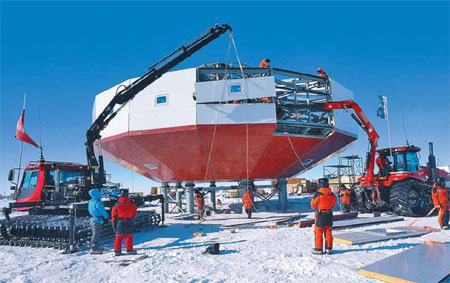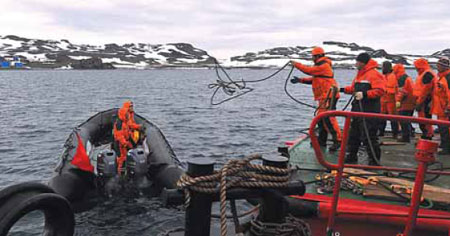Spirit of adventure lives on in Antarctic
Updated: 2014-02-19 07:04
By Zhang Lei and Dong Fangyu in Beijing (China Daily USA)
|
|||||||||
China establishes fourth research station to study ecology and meteorology on South Pole, report Zhang Lei and Dong Fangyu in Beijing.
When Ernest Shackleton failed in his attempt to reach the South Pole 103 years ago, the British adventurer bemoaned what he saw as growing reluctance to explore the world.
However, a century after his doomed expedition, journeys into uncharted territory are still very much in vogue.
Antarctica is now home to more than 40 permanently manned international research stations, and 50 countries have signed the Antarctic Treaty, which ensures the status of the continent - the only one in the world without an indigenous human population - as a scientific preserve.
The opening on Feb 8 of Taishan, China's fourth Antarctic research station, is a further testament to the spirit of adventure.
The 1,000-square-meter station, named after one of China's most famous mountains, is located between two existing stations, Zhongshan and Kunlun, at an altitude of 2,621 meters and with an annual average temperature of -36.6 C. After Kunlun, Tai-shan is China's second inland expedition station in Antarctica, but will serve as a summer station because the facility can only be used from November to March.
Shaped like a giant Chinese lantern, the station is being threatened by continuous snowstorms, which show no signs of dying down, and have resulted in the 20-person crew retreating to Zhongshan Station on the coast, a journey of approximately 30 days.
Qu Tanzhou, director of the Chinese Arctic and Antarctic Administration, said Taishan Station is a critical step toward China expanding its ambitious Antarctic research program.
"Previously, when our team traveled from Zhongshan to Kunlun, we had to transport huge quantities of daily necessities because there is no midway supply point, and if severe weather occurs, we have nowhere to stay," he said.
A different reality
Life in Antarctica is not at all how the uninitiated perceive this icebound land, imagining perhaps a carpet of glistening snow covering the hillsides and reflecting the crystal-clear blue skies, and female penguins diving into the freezing water, bringing back food for their partners and offspring. To people with a poetic vision, Antarctica is a continuation of the natural life, but to those on expeditions, the reality is vastly different.
Cui Xiangbin, a glaciology researcher with the Polar Research Institute of China, stayed at Kunlun Station as a member of China's 28th Antarctic exploration team in 2012. His project was to study the dynamics of the ice sheet by exploring subglacial topography and internal layers via ice-penetrating radar.
At an altitude of 4,093 meters, Kunlun is China's highest Antarctic research establishment, Cui said, as he explained the difficulties inherent in traveling between the stations.
To get to Kunlun Station, for example, his team had to leave Zhongshan Station on the coast and travel 1,300 kilometers in caterpillar-tracked vehicles for more than 20 days.
"Although we carried tons of supplies with us on sleds and snowmobiles, we were still badly in need of drinking water and vegetables," he said. "It took a huge amount of time and energy to melt the ice and sterilize it."
However, the difficulties experienced at inland Antarctica research stations during the summer season are nothing when compared to the rigors faced by "winter-over" teams, especially because they had to undergo nearly two months without sunlight, said Cui.
In such an unforgiving environment, team members are likely to develop "winter-over syndrome," which can involve depression, irritability, insomnia, anger, and a variety of behavioral and medical disorders.
Qu said that once Taishan Station becomes fully operational, the researchers will be able to store enough fuel and supplies to allow them to fully recharge their batteries when they return from Kunlun Station, and will also greatly reduce the loads carried by the tracked vehicles.
'I love you'
The research team has nicknamed Taishan Station "520", because it's 520 km from Zhongshan Station, and in Chinese, "520" is phonetically similar to "I love you."
Among the advantages Taishan Station enjoys are an ice runway for fixed-wing aircraft and the 400-metric-ton inland transport vehicles and equipment with which the establishment has been fitted, helping to provide logistical support for Kunlun station.
"The purchase of fixed-wing aircraft is currently under way. The use of aircraft will greatly improve the efficiency of cargo transport between the four stations (the others are Zhongshan, the Great Wall and Kunlun), particularly in dealing with illnesses, injuries and other unpredictable circumstances. If sensor devices are installed, the aircraft can carry out a wider range of air monitoring," he said.
Currently the only way the team can travel between the stations is by a snowmobile, which resembles a tank. Instead of wheels, it has large caterpillar tracks which allow it to climb steep, snow-covered hills, but on the downside, its top speed is a mere 30 km per hour, meaning it takes a month to ferry materials and necessities from Zhongshan Station to Kunlun Station.
Fixed-wing aircraft are expected to begin missions in 2015. Once it becomes easier to transport supplies to Kunlun, the station will be upgraded to an all-year research establishment, and Taishan's role will be expanded to include that of a training base.
The lantern-shaped architecture at Taishan Station is supported by eight cylindrical bars, and, according to the designer, chief engineer Wang Zhongjun, the exterior design combines elements from science fiction that make it look like a UFO. However, the design wasn't predicated on appearance alone.
"Buildings in Antarctica cause disturbances in the wind field. Strong winds will bring snow that will cover the station and although the annual snowfall around Taishan Station is only two or three centimeters, even large buildings can easily be buried in just two years. Moreover, because there is no spring thaw in Antarctica, the snow will also accumulate to the point where its weight will crush or deform the station," Wang said.
To solve this problem, the main body of the station is built around a streamlined design, while the entire building is set on stilts 2 meters above the ground, not only to improve wind resistance, but also to help blow away the snow near the building.
Climate change research
A wide range of scientific research will be conducted at Taishan Station, including monitoring of the ecosystem and meteorological observations. The pattern of changes in sea ice is a sensitive indicator of global climate change and the environment. In addition, the team will also undertake research into glaciology, astronomy, atmospheric chemistry, geology and marine biology.
"Antarctica, the most intact, undeveloped continent, contains endless science enigmas, and it plays a crucial role in research into global climate change", said Zhao Yong, who was the leader at Zhongshan Station during the 27th Chinese National Antarctic Expedition in 2010.
Most of the research is usually carried out during the Antarctic summer because when winter arrives, environmental constraints mean that many research projects have to be suspended. However, the "wintering over" scientists will remain at the research stations to collect data relating to meteorological observations, the tides, geomagnetism and global positioning satellites, according to Zhao.
While conducting their research, the Chinese scientists strictly observe the rules stipulated in the Protocol on Environmental Protection to the Antarctic Treaty. "Every one of us is keenly aware of the need to protect the Antarctic environment," said Zhao. "Those who go outside to smoke always take along a little glass jar to put their cigarette butts in."
Equipment to reduce carbon emissions has also been incorporated into Taishan Station. The three other Antarctic stations rely on diesel thermal power, which is generated through the use of diesel fuel. That means they are reliant on external fuel deliveries, which are extremely expensive, and the fuel is limited.
Instead, the Taishan Station will use wind and solar power systems as efficient energy sources capable of heating the rooms to around 20 C. The station is also equipped with a simple bathroom and a kitchen, amenities that provide previously unknown facilities such as regular showers. In the past, the team members were restricted to just one shower a month, and even that was considered something of a luxury
Qu said plans are in the pipeline to build a fifth Chinese Antarctic station, near the Ross Sea, which is relatively close to the South Pole. Upon its completion, China will have three stations facing oceans: the Pacific, the Atlantic and the Indian.
Contact the writers at zhanglei@chinadaily.com.cn and dongfangyu@chinadaily.com.cn
|
China's fourth Antarctic research base, Taishan Station, can be used for scientific observations, accommodation, power generation, storage, maintenance of machinery, communications and as an emergency shelter. It also has oil storage installations and equipment to support a 400-metric-ton inland vehicle fleet. Xinhua |
|
Scientists from the Chinese research vessel and icebreaker Xuelong on their way to retrieve a floating marker the team left in the sea near the Great Wall Station two years ago. Zhang Jiansong / Xinhua |
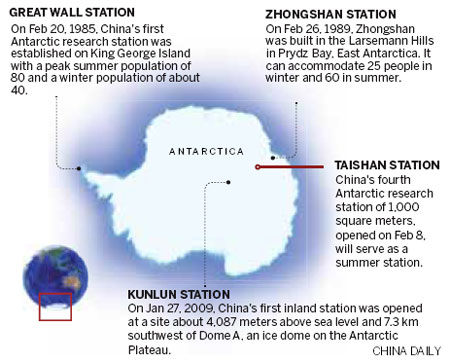
(China Daily USA 02/19/2014 page7)
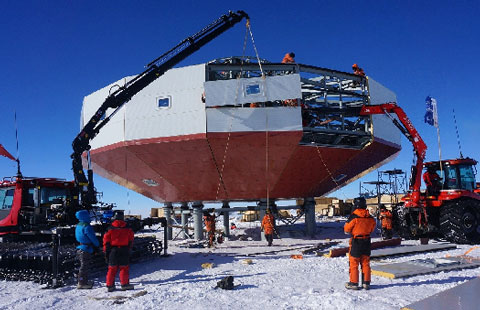
 Spirit of adventure lives on in Antarctic
Spirit of adventure lives on in Antarctic
 Prince Charles dances in traditional Saudi dress
Prince Charles dances in traditional Saudi dress
 Maglev trains speeding toward greener future
Maglev trains speeding toward greener future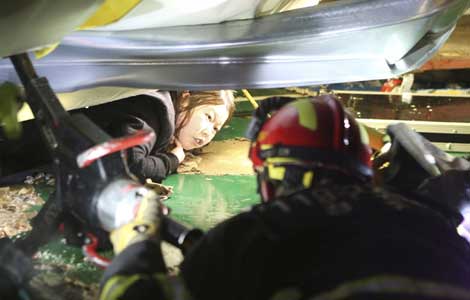
 Building collapse at Korean resort kills 10
Building collapse at Korean resort kills 10
 The big ballet stage
The big ballet stage
 17 more cement plants biting the dust
17 more cement plants biting the dust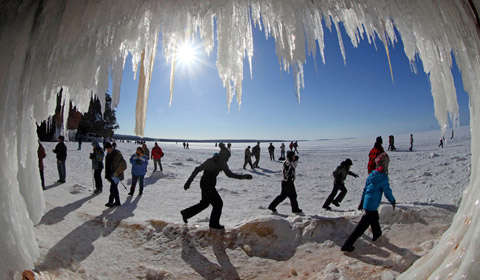
 World's largest freshwater lake frozen
World's largest freshwater lake frozen
 American photographer wins World Press Photo 2013
American photographer wins World Press Photo 2013
Most Viewed
Editor's Picks

|

|

|

|

|

|
Today's Top News
Reforms to put safety first for low-level flights
PLA soldiers bigger, need new gear
China's aviation school banks on global ties
Green timber preferred overseas but not locally
NHK head regrets history words
Police to root out organizers of prostitution
Li to officials: Move ahead with improvements
'Equal' talks open to Taipei
US Weekly

|

|
